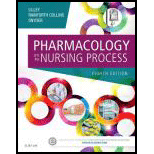
To describe:
The functions of the sympathetic nervous system and the specific effects of adrenergic stimulation.
Concept Introduction:
The central nervous system (CNS) and peripheral nervous system (PNS) are considered as the two important branches of the nervous system. The CNS consists of the spinal cord and brain, whereas the PNS contains autonomic (ANS) and somatic nervous system (SNS). The ANS is further divided into the sympathetic or adrenergic and parasympathetic or cholinergic. It is more important to understand the action of many drugs in these systems. Adrenergic or sympathetic compounds include the substances which are related to the body’s natural substances (endogenous) and synthetic substances (exogenous).
Explanation of Solution
Functions of the sympathetic nervous system:
Adrenergic compounds are involved in the therapeutic effects with the help of their receptors. It stimulates the SNS and it is called as adrenergic agonists. It is also known as sympathomimetic because it mimics the SNS neurotransmitters effects such as norepinephrine, dopamine, and epinephrine. These neurotransmitters are classified in terms of chemical nature as catecholamines. The G-protein coupled adrenergic receptors are targets the catecholamines neurotransmitters such as epinephrine (adrenaline) and norepinephrine (noradrenaline). These adrenergic receptors of the SNS provide the check and balance system to maintain the body homeostasis.
Specific effects of adrenergic stimulation:
It involves the flight or fight responses to acute stress and it is activated due to the unexpected release of hormones. It is also involved in the pupil widening, blood flow diverting from organs to the skeletal muscle.
Thus, the functions and specific effects of adrenergic compounds of the SNS involves the body homeostasis and stimulates the fight or flight responses.
Want to see more full solutions like this?
Chapter 18 Solutions
Pharmacology and the Nursing Process, 8e
- overview of the neurological system, cranial nerves and what part of the body it innervatesarrow_forwarddifferentiate structure and function of the peripheral vascular system. what are the normal and abnormal findings of the peripheral arterioles and peripheral venous systemarrow_forwardAn overview of the skin, hair and nails epidermal appendages normal and abnormal findingsarrow_forward
- differentiate the twelve cranial nerves and how to test themarrow_forwardWhat are the nursing interventions for patients with GI problems ? What is the priority ?arrow_forwardAdult Nutrition Assessment Date of consultation: 3/2/25 Reason for Nutrition Assessment: Mrs. Clover was referred to the RD from the ER physician; patient experiencing weight loss, SOB & Edema Nutrition Assessment Data 69 YOF Ht 157 cm, Wt 53 kg. BMI 21.7 Usual wt 55 kg Heart: slight physiologic murmur; lungs: clear; extremities: 3+ edema to bilateral lower legs; elevated BP, abdomen: soft, nontender, active bowel sounds; neurologic: unremarkable; skin: diminished skin tugor. Biochemical Data BUN 72, Creatinine 4.6, Calcium 7.2, Phosphorus 7.3, glucose 105, BNP 720, Albumin 2.0, Na 125, K 3.3, CI 93. Hgb 11.5, Hct 33.2, ALT 29, AST 36, Alkaline phosphatase 120, other relevant labs pending result. Medications Include inhalers, Cymbalta, Neurontin, Seroquel, and topiramate, prilosec, solumedrol, rocephin, zithromax, NaCl 0.45%+50 MEQ sodium bicarbonate @100 ml/hr. No history of herbal supplements. Since her pneumonia diagnosis several days ago, she has felt too weak to prepare meals, she…arrow_forward
- Assuming you are a community health nurse, choose a community of your own and perform practically the following and report your findings: a. Community Assessment b. Community Diagnosisarrow_forwardDescribe practically how you would use a standing order in the diagnosis and treatment of a 10-year-old primary school pupil with a complaint of haematuria at the end of the urine.arrow_forwardSimple explanations, please. B. Why is an accurate diagnosis of malnutrition important? H. Is BMI a food indicator of malnutrition? I. Can an overweight/obese patient develop malnutrition? Why or why not?arrow_forward
- How is the severity of malnutrition determined based off the table? Simple explanation please.arrow_forwardDiscuss on: 1. Peptic Ulcer disease Aetiology 2. Classification of drugs used in the treatment of PUD 3. Triple therapy of PUD 4. Drugs Contraindicated in PUDarrow_forwardCATH LAB FUNDAMENTALS I WORKSHEET #2 Patient #1 NAME: AO 232/112 M CaO2 ml/L LV 232/25 CvO2 ml/L RA M 17 C.O. L/Min RV 61/17 S.V. ml/beat PA 61/25 M C.I. L/Min/M2 PAW M 25 S.I. ml/beat/M2 Hgb 10.3 S.V.R Dynes/sec/cm5 Hct % T.P.R Dynes/sec/cm5 PA Sat 56% P.V.R Dynes/sec/cm5 AO Sat 81% BSA M2 HR 113 BPM 02 Cons. 233 ml/min Ht _5_ft_10_in Wt. _330_lbs Patient#2 AO 78/46 M CaO2 ml/L LV 78/10 CvO2 ml/L RA M---7 C.O. L/Min RV 21/7 S.V. ml/beat PA 21/12 M C.I. L/Min/M2 PAW M- 12- S.I. S.V.R ml/beat/M2 Dynes/sec/cm5 Hct 45%…arrow_forward
 Phlebotomy EssentialsNursingISBN:9781451194524Author:Ruth McCall, Cathee M. Tankersley MT(ASCP)Publisher:JONES+BARTLETT PUBLISHERS, INC.
Phlebotomy EssentialsNursingISBN:9781451194524Author:Ruth McCall, Cathee M. Tankersley MT(ASCP)Publisher:JONES+BARTLETT PUBLISHERS, INC. Gould's Pathophysiology for the Health Profession...NursingISBN:9780323414425Author:Robert J Hubert BSPublisher:Saunders
Gould's Pathophysiology for the Health Profession...NursingISBN:9780323414425Author:Robert J Hubert BSPublisher:Saunders Fundamentals Of NursingNursingISBN:9781496362179Author:Taylor, Carol (carol R.), LYNN, Pamela (pamela Barbara), Bartlett, Jennifer L.Publisher:Wolters Kluwer,
Fundamentals Of NursingNursingISBN:9781496362179Author:Taylor, Carol (carol R.), LYNN, Pamela (pamela Barbara), Bartlett, Jennifer L.Publisher:Wolters Kluwer, Fundamentals of Nursing, 9eNursingISBN:9780323327404Author:Patricia A. Potter RN MSN PhD FAAN, Anne Griffin Perry RN EdD FAAN, Patricia Stockert RN BSN MS PhD, Amy Hall RN BSN MS PhD CNEPublisher:Elsevier Science
Fundamentals of Nursing, 9eNursingISBN:9780323327404Author:Patricia A. Potter RN MSN PhD FAAN, Anne Griffin Perry RN EdD FAAN, Patricia Stockert RN BSN MS PhD, Amy Hall RN BSN MS PhD CNEPublisher:Elsevier Science Study Guide for Gould's Pathophysiology for the H...NursingISBN:9780323414142Author:Hubert BS, Robert J; VanMeter PhD, Karin C.Publisher:Saunders
Study Guide for Gould's Pathophysiology for the H...NursingISBN:9780323414142Author:Hubert BS, Robert J; VanMeter PhD, Karin C.Publisher:Saunders Issues and Ethics in the Helping Professions (Min...NursingISBN:9781337406291Author:Gerald Corey, Marianne Schneider Corey, Cindy CoreyPublisher:Cengage Learning
Issues and Ethics in the Helping Professions (Min...NursingISBN:9781337406291Author:Gerald Corey, Marianne Schneider Corey, Cindy CoreyPublisher:Cengage Learning





